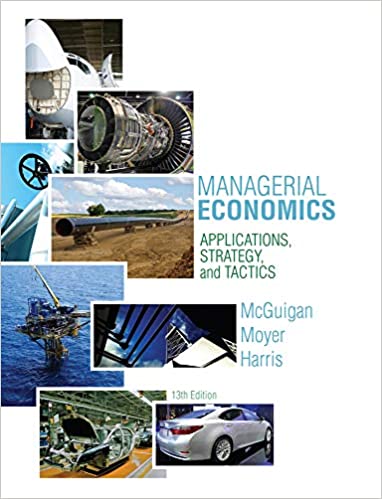
Managerial Economics 13th Edition by James McGuigan,Charles Moyer,Frederick Harris
Edition 13ISBN: 978-1285420929
Managerial Economics 13th Edition by James McGuigan,Charles Moyer,Frederick Harris
Edition 13ISBN: 978-1285420929 Exercise 9
Designing a Managerial Incentives Contract
Specific Electric Co. asks you to implement a pay-for-performance incentive contract for its new CEO and four EVPs on the Executive Committee. The five managers can either work really hard with 70 hour weeks at a personal opportunity cost of $200,000 in reduced personal entrepreneurship and increased stress-related health care costs or they can reduce effort, thereby avoiding the personal costs. The CEO and EVPs face three possible random outcomes: the probability of the company experiencing good luck is 30 percent, medium luck is 40 percent, and bad luck is 30 percent. Although the senior management team can distinguish the three "states" of luck as the quarter unfolds, the Compensation Committee of the Board of Directors (and the shareholders) cannot do so. Once the board designs an incentive contract, soon thereafter the good, medium, or bad luck occurs, and thereafter the senior managers decide to expend high or reduced work effort. One of the observable shareholder values listed below then results.

Assume the company has 10 million shares outstanding offered at a $65 initial share price, implying a $650,000,000 initial shareholder value. Since the EVPs and CEOs effort and the company's luck are unobservable to the owners and company directors, it is not possible when the company's share price falls to $50 and the company's value to $500,000,000 to distinguish whether the company experienced reduced effort and medium luck or high effort and bad luck. Similarly, it is not possible to distinguish reduced effort and good luck from high effort and medium luck.
Answer the following questions from the perspective of a member of the Compensation Committee of the board of directors who is aligned with shareholders' interests and is deciding on a performance-based pay plan (an "incentive contract") for the CEO and EVPs.
Design an incentive plan that seeks to elicit high effort by granting restricted stock. Show that one-half million shares granted at $70 improves shareholder value relative to all prior alternatives.
Specific Electric Co. asks you to implement a pay-for-performance incentive contract for its new CEO and four EVPs on the Executive Committee. The five managers can either work really hard with 70 hour weeks at a personal opportunity cost of $200,000 in reduced personal entrepreneurship and increased stress-related health care costs or they can reduce effort, thereby avoiding the personal costs. The CEO and EVPs face three possible random outcomes: the probability of the company experiencing good luck is 30 percent, medium luck is 40 percent, and bad luck is 30 percent. Although the senior management team can distinguish the three "states" of luck as the quarter unfolds, the Compensation Committee of the Board of Directors (and the shareholders) cannot do so. Once the board designs an incentive contract, soon thereafter the good, medium, or bad luck occurs, and thereafter the senior managers decide to expend high or reduced work effort. One of the observable shareholder values listed below then results.

Assume the company has 10 million shares outstanding offered at a $65 initial share price, implying a $650,000,000 initial shareholder value. Since the EVPs and CEOs effort and the company's luck are unobservable to the owners and company directors, it is not possible when the company's share price falls to $50 and the company's value to $500,000,000 to distinguish whether the company experienced reduced effort and medium luck or high effort and bad luck. Similarly, it is not possible to distinguish reduced effort and good luck from high effort and medium luck.
Answer the following questions from the perspective of a member of the Compensation Committee of the board of directors who is aligned with shareholders' interests and is deciding on a performance-based pay plan (an "incentive contract") for the CEO and EVPs.
Design an incentive plan that seeks to elicit high effort by granting restricted stock. Show that one-half million shares granted at $70 improves shareholder value relative to all prior alternatives.
Explanation

This question doesn’t have an expert verified answer yet, let Examlex AI Copilot help.
Managerial Economics 13th Edition by James McGuigan,Charles Moyer,Frederick Harris
Why don’t you like this exercise?
Other Minimum 8 character and maximum 255 character
Character 255


